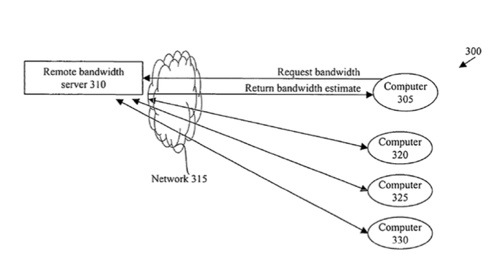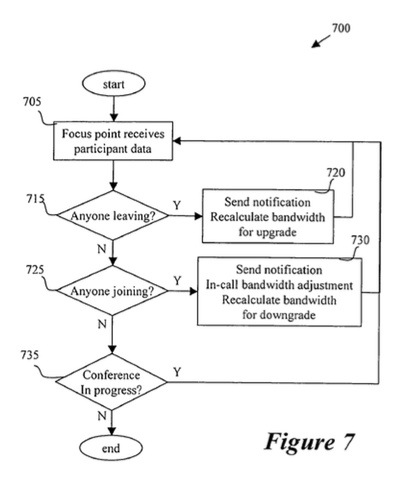An Apple patent (number 8243905) for a multi-participant conference set-up has appeared at the U.S. Patent & Trademark Office. The architecture has one participant's computer in the conference act as a central content distributor for the conference.
The central distributor receives data (e.g., video and/or audio streams) from the computer of each other participant, and distributes the received data to the computers of all participants. In some embodiments, the central distributor receives A/V data from the computers of the other participants. From such received data, the central distributor of some embodiments generates composite data (e.g., composite image data and/or composite audio data) that the central distributor distributes back to the participants.
Here's Apple's background and summary of the invention: "In recent years, users of local and wide area networks (e.g., the Internet) have upgraded to increasingly higher bandwidth connections. The common user also has access to greater computer hardware processing power. At the same time, the coders and decoders (codecs) for video transmission over a network connection have seen improvements such that an individual user has the capability to stream and receive real-time video over the Internet with off-the-shelf components. All this has allowed individual users to begin chatting, sharing, and videoconferencing with point-to-point technologies on their computers.
"However, bandwidth remains a constrained resource that must be shared over many users. Likewise, processing power is typically shared by the operating system and several applications in a typical user's computer hardware. These factors have been barriers to the use of personal computers in establishing a conference with more than two participants. Such a conference will be referenced below as a multi-participant conference.
"Several approaches are possible for multi-participant conferencing. One such approach is the full-mesh topology, which is the extension of two-participant point-to-point methods to multi-participant conferencing. Under the full-mesh topology, each participant sends all of its audio and/or video (A/V) data to all other participants in the multi-participant conference. However, the full mesh topology requires a high amount of processing power and broad bandwidth at and between each participant of the multi-participant conference.
"Even with just a few participants, the full-mesh topology quickly becomes untenable because each participant and each network connection is responsible for sending and receiving a burdensome amount of data. Moreover, the weakest connection or hardware point determines the maximum capability of a conference for all participants in the full-mesh topology.
"The star topology is another possible approach for multi-participant conferencing. In prior art this approach uses a central server to receive data from all participants in the conference and send all that data back out to each participant. The required server needs high bandwidth and processing power. The server requirements scale with the number of conferences to be hosted, making this approach unusable for wide scale deployment.
"Thus, there is a need in the art for a better architecture for multi-participant conferencing. Ideally, such an architecture would allow the participants to use off-the-shelf computers and typically available bandwidth and not require the deployment of dedicated servers.
"Some embodiments provide an architecture for establishing a multi-participant conference. This architecture has one participant's computer in the conference act as a central content distributor for the conference. The central distributor receives data (e.g., video and/or audio streams) from the computer of each other participant, and distributes the received data to the computers of all participants.
"In some embodiments, the central distributor receives A/V data from the computers of the other participants. From such received data, the central distributor of some embodiments generates composite data (e.g., composite image data and/or composite audio data) that the central distributor distributes back to the participants.
"The central distributor in some embodiments can implement a heterogeneous audio/video conference. In such a conference, different participants can participate in the conference differently. For instance, different participants might use different audio or video codecs. Moreover, in some embodiments, one participant might participate in only the audio aspect of the conference, while another participant might participate in both audio and video aspects of the conference."
The inventors are Hyeonkuk Jeong, Joe Abuan, Jim Normile, Ryan Salsbury and Berkat Hsing Tung.














